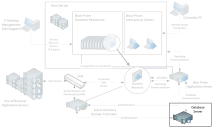Blue Prism database server
Blue Prism database server
Each Blue Prism environment uses a Microsoft SQL database as a central repository of configuration data, settings, runtime transactions and logs.
The solution permits any number of instances of the Blue Prism schema to be deployed within a given SQL instance on Microsoft SQL Server, allowing multiple Blue Prism environments to be configured within a single Microsoft SQL instance.
Support is also provided for Microsoft SQL Azure. Refer to the Blue Prism Reference Architecture for Microsoft Azure for further details.
Key features:
- Central repository for all Blue Prism configuration information such as processes, objects, and workflow configuration.
- Third-party system user credentials store.
- Work queue repository.
- Stores audit information and production process log data – a transaction log of each process running in the environment.
Minimum requirements: database server
The latest information about the minimum specifications of each Blue Prism component can be found in Blue Prism software and hardware requirements.
Sizing
The requirements of the database server directly correlate to the number of deployed Blue Prism Runtime Resources. Data file size should be reviewed during implementation according to logging requirements, running hours and data retention policy as this will vary if data is retained for prolonged periods. Backup and log truncation should be reviewed according to business criticality.
Frequently asked questions: database server
How are Blue Prism Databases typically deployed?
The database can be deployed to a physical SQL Server instance. Alternatively, it can be deployed to a high-specification, well configured, virtualized database. It is common for non-production databases to be contained within a single SQL instance, and for the production databases to be hosted within a production-strength single SQL instance (often one which offers redundancy through mirroring, clustering or use of AlwaysOn Availability Groups (SQL AAG)).
What are the security implications of this component?
As with all application databases, the Blue Prism database(s) must be secured as this database is the main repository for a range of information including: process configuration; credentials for third-party systems; work queues; logs and audit information.
The sensitive data is encrypted prior to storage however this is not a substitute for database security.
Can a single Blue Prism Database Server be used across multiple environments?
A single Blue Prism Database Server can be used across multiple Blue Prism environments as each environment requires an independent database which can be co-hosted with other Blue Prism databases on a single SQL instance.
Does this component need to be backed up?
Yes, it is important to ensure that the database and logs are subject to frequent, full backups (a complete backup of your SQL Server database) and are also in line with your own data recovery policies.
Are PaaS databases supported?
Yes, your Blue Prism database can be deployed as a service (PaaS) database engine. Currently, Azure SQL, Azure Managed Instance, and AWS RDS are supported databases.




No comments